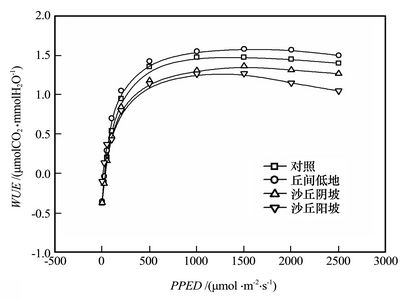Water Physiological Characteristics of Nitraria tangutorum Leaves in Yabrai Sandstorm Belt under Different Water Condition
Updatetime:2010-12-07From:
【Enlarge】【Reduce】
The leaf osmotic potential (Ψs), leaf water content (LWC), net photosynthesis rate(Pn), transpiration rate(Tr) and stomatal conductance of Nitraria tangutorum leaves were investigated in the four main habitats of Yabrai sandstorm belt, i. e., fixed sand dunes (south facing and north facing), lowland and contrast point. The relationships between the leaf osmotic potential and leaf water content, as well as growth forms and habitats were also examined. The leaf osmotic potential value of Nitraria tangutorum leaves was -3.11 MPa, -2.02 MPa, -1.34 MPa and -1.21 MPa for the four main habitats. The leaf osmotic potential increased with the soil water potential, in the rank of fixed sand dune<lowland<contrast point. The leaf osmotic potential values of different growth forms were ordered as follows: the south facing slopes of fixed sand dune < the north facing slopes of fixed sand dune<lowland<contrast point(P<0.01). Moreover, leaf water contents similar to the leaf osmotic potential were recorded in the four main habitats. It is also found a positive correlation existing between the leaf osmotic potential and leaf water content (P<0.001) and an exponential relationship between the leaf osmotic potential and stomatal conductance in all habitats (P<0.01). Within the range of 0~2 500 μmol·m-2·s-1 of photosynthetic active radiation, net photosynthesis rate increased with soil water content, and transpiration rate increased with photosynthetic active radiation. In the light of the average net photosynthesis rate and the average water use efficiency, the soil water content, in which both the solar energy utilization efficiency and the water use efficiency of Nitraria tangutorum leaves are better, is about 7%.
 |
Appendix




